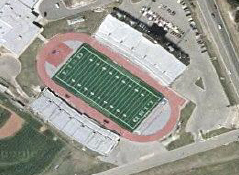 Built originally in West Texas in 1947 as a
reward for the Odessa High Bronchos' winning of the state
championship the year before, the facility surrounded the
same football playing field. This facility was called
Broncho Stadium in those days and was located on what is
now the Odessa College Sports Complex. The OHS
Bronchos had the venue to themselves for over a decade,
but Ector County ISD expansion in the start of the 1960s
would bring a new tenant to W.T. Barrett Stadium.
The
new school would quickly overshadow its cross-town rival,
and from the early sixties onward, Barrett Stadium would
be most widely known as the fearsome home field of one of
America's most storied high school football programs: the
magical Mojo, the Panthers of Odessa Permian. Titanic
clashes in a tough district nicknamed "The Little
Southwest Conference" were played out on the floor of this
stadium, including some historic wars between heated
rivals Permian and Midland Lee. Ector County ISD
decided to expand their seating capacity in 1981 and
Barrett Stadium's farewell season would make way to the
new 19,302-seat Ratliff Stadium. It would open for
the 1982 football season.
In
1985, prodigious growth in Leander ISD required the
building of a larger athletic stadium than the tiny
bleachers out on the side of the original Leander High
School (now Leander Middle School). When the new Leander
High campus was built on its current site, LISD purchased
the components of Barrett Stadium from Odessa and
transported the disassembled facility to central Texas
aboard 57 tractor-trailer rigs.
The
stadium was reassembled on the site it now occupies,
straddling the municipal border of the cities of Leander
and Cedar Park. It was named "Lion Stadium" and carried
that name for as long as Leander ISD operated only the
single high school, from the stadium's resurrection in
1985 through 1997.
 As
originally rebuilt, the stadium consisted of wooden seats
and floors, and encompassed a grass playing field. During
a Leander / Round Rock game in 1997, a Round Rock drill
team member standing on her bench seat on the visitor's
side broke through the aging wood and fell several feet to
the ground beneath the stadium, breaking a leg. This
accident spotlighted the need for modernization. All wood
throughout the stadium, including walkway ramps up to the
entry portals, was replaced with aluminum. As
originally rebuilt, the stadium consisted of wooden seats
and floors, and encompassed a grass playing field. During
a Leander / Round Rock game in 1997, a Round Rock drill
team member standing on her bench seat on the visitor's
side broke through the aging wood and fell several feet to
the ground beneath the stadium, breaking a leg. This
accident spotlighted the need for modernization. All wood
throughout the stadium, including walkway ramps up to the
entry portals, was replaced with aluminum.
In
1998, with the building of Cedar Park High, it was
realized that sharing the facility between two schools
would rapidly wear out the natural grass field. New
Astroturf was procured and finally installed prior to the
2000 season. Also in 1998, the stadium's and scoreboard's
blue and red color scheme was replaced with a more neutral
black and white and gray, in order not to favor one school
over the other. For the same reason, the name was changed
from Lion Stadium to the current A.C. Bible Memorial.
Bible is also the tallest high school stadium in central
Texas. Access to the underside of the press box is via
seven flights of switchback stairs under the stadium. To
facilitate low-row fans seeing over the track and the
players on the sideline, row 1 is elevated a full 10 feet
off the ground. The 45th row of seats is fully 40 feet
above the parking lot, and the top level of the press box
is 60 feet in the air, as high as a six-story building. |